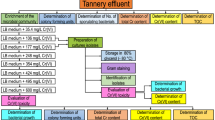Abstract
A bacterial community obtained by continuous enrichment from the microbial population of tannery effluent using pentachlorophenol (PCP) as sole source of carbon and energy, contained four different bacterial species including Serratia marcescens (three isolates, TE1, TE2 and TE4) and Pseudomonas fluorescens (one isolate, TE3). The members of the community grew separately on various chlorinated compounds, carbon and nitrogen sources and exhibited a remarkable ability to utilize PCP. Biodegradation studies revealed a time-dependent disappearance of PCP and its intermediary metabolites, tetrachloro-p-hydroquinone and chlorohydroquinone, and indicated the individual role of members of the community in the degradation of PCP.
Similar content being viewed by others
References
Apajalathi, J.H., Karpahoja P. & Salkinoja Salonen, M.S. 1986 Degradation of polychlorinated phenolsby Rhodococcus chlorophenolicus. Applied Microbiology and Biotechnology 25, 62–67.
Bouwer, J.E. & Zehnder, X.J.B. 1984 Anaerobic biodegradation of chlorophenols in fresh and acclimated sludge. Applied and Environmental Microbiology 47, 272–277.
D'angelo, E.M. & Reddy, K.R. 2000 Aerobic and anaerobic transformations of pentachlorophenol in wetland soils. Soil Science Society of America Journal 64, 933–943.
Escher, B.I., Snozzi, M. & Schwarzenbach, R.P. 1996 Uptake, speciation and uncoupling activity of substituted phenols in energy transducing membranes. Environmental Science and Technology 30, 3071–3079.
Kanters, M.J., Nispen, R.V., Louw, R. & Mulder, P. 1996 Chlorine input and chlorophenol emission in the lab scale composition of municipal solid waste. Environmental Science and Technology 30, 2121–2126.
Kringstad, K.P. & Lindstrom, K. 1984 Spent liquors from pulp bleaching. Environmental Science and Technology 18, 236–248.
Mikesell, M.D. & Boyd, S.A. 1985 Reductive dechlorination of the pesticides 2,4 D, 2,4,5 T and pentachlorophenol in anaerobic sludges. Journal of Environmental Quality 14, 337–340.
Mileski, G.J., Bumpus, J.A., Jurek, M.A. & Aust, S.D. 1988 Biodegradation of pentachlorophenol by the white rot fungus Phanerochaete chrysosporium. Applied and Environmental Microbiology 54, 2885–2888.
Pfennig, N. & Lippert, K.D. 1966 über das vitamin B-12-bedüronis phototropher schwefetabacterien. Archiv fuü Mikrobiologie 55, 245–256.
Radehaus, P.M. & Schmidt, S.K. 1992 Characterization of novel Pseudomonas sp. that mineralizes high concentration of PCP. Applied and Environmental Microbiology 56, 1392–1396.
Saber, D.L. & Crawford, R.L. 1985 Isolation and characterization of Flavobacterium strains that degrade pentachlorophenol. Applied and Environmental Microbiology 50, 1512–1518.
Shukla, S., Sharma, R. & Thakur, I.S. 2001 Enrichment and characterization of pentachlorophenol degrading microbial community for the treatment of tannery effluent. Pollution Research 20, 353–363.
Slater, J.H. & Lovatt, D. 1984 Biodegradation and the signi.cance of microbial communities. In Microbial Degradation of Organic Compounds, ed. Gibson, D.T. pp. 439–485. New York: Marcel Dekker. ISBN 0-82477102-8.
Stanlake, G.J. & Finn, R.K. 1982 Isolation and characterization of a pentachlorophenol degrading bacterium. Applied and Environmental Microbiology 44, 1421–1427.
Thakur, I.S. 1995 Structural and functional characterization of a stable, 4-Cholorosalicylic-acid-degrading, bacterial community in a chemostat. World Journal of Microbiology and Biotechnology 11, 643–645.
Thakur, I.S., Verma, P.K. & Upadhaya, K.C. 2001 Involvement of plasmid in degradation of pentachlorophenol by Pseudomonas sp. From a chemostat. Biochemical and Biophysical Research Communications 286, 109–113.
Thakur, I.S., Verma, P.K. & Upadhaya, K. 2002 Molecular cloning and characterization of pentachlorophenol degrading monooxygenase gene in Pseudomonas sp. from chemostat. Biochemical and Biophysical Research Communications 290, 770–774.
Toope, E., Crawford, R.L. & Hanson, R.S. 1988 Influence of readily metabolizable carbon on pentachlorophenol metabolism by pentachlorophenol degrading Flavobacterium sp. Applied and Environmental Microbiology 54, 2452–2459.
Xun, L. & Orser, C.S. 1991 Purification of a Flavobacterium pentachlorophenol-induced periplasmic protein (pcpA) and nucleotide sequence of the corresponding gene (pcpA). Journal of Bacteriology 173, 2920–2926.
Author information
Authors and Affiliations
Rights and permissions
About this article
Cite this article
Shah, S., Thakur, I.S. Enrichment and characterization of a microbial community from tannery effluent for degradation of pentachlorophenol. World Journal of Microbiology and Biotechnology 18, 693–698 (2002). https://doi.org/10.1023/A:1016854205789
Issue Date:
DOI: https://doi.org/10.1023/A:1016854205789




